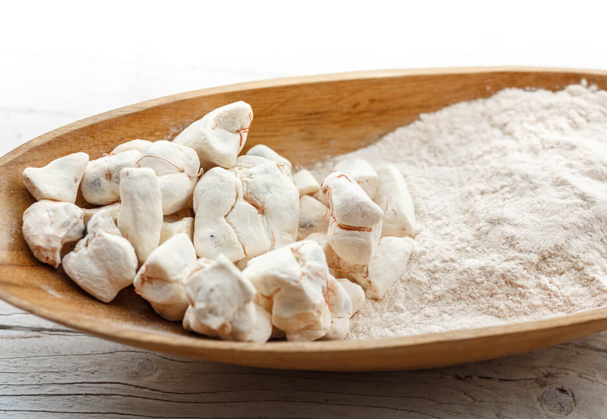Adansonia digitata L.
Baobab is used in folk medicine as an antipyretic or febrifuge to overcome
fevers. Both leaves and fruit pulp are used for this purpose. Fruit pulp and powdered seeds are used in cases of dysentery and to promote perspiration
(i.e. a diaphoretic).
Maybe the widest use in folk medicine is the use of the bark as a substitute
for quinine in cases of fever or as a prophylactic.
Externally, use is made of young leaves, crushed into a poultice, for
painful swellings.

Plant (A. digitata L.)

Fruits (A. Digitata L.)
Adansonia digitata L.
Bombacaceae
Common Name (Ar.): Tabaldi, Gongolaise (fruits of); (Eng.): Baobab, Vegetative elephant; (Synonyms): A. baobab Gaertn., A. situla.
Lowland plains, Wadis, stream banks. Widespread throughout Western and Central Sudan.
Leaves, bark, and seeds.
Deciduous trees up to 20 m high with whitish or silvery- grey and shiny barks. Leaves alternate, compound, palmate, penta-foliate up to 20 cm long, leaflets elliptic, 3.5-10×1.3-4cm, apex acuminate, base cuneate, margin entire. Inflorescences solitary, peduncles up to 1 m long. Flowers white, 5-8cm across, with setose-tomentose sepals and numerous stamens. Fruits berry, ovoid-oblong, up to 25 cm long, grey-brown, velvet, filled with whitish pulp divided longitudinally by fibrous septae.
Adansonin which has a cardiotonic effect was isolated from the stem bark of the plant in addition to quercetin-7-b-D xylopy-5-ranoside. The seed contains tocophenols while the seed oil contains arachidic, linoleic, palmitic and stearic acid. The fruit was found to be rich in organic acids (tartaric, malic and citric acid) and their potassium salts in addition to Ca, pectin and vitamin C.
The maceration of the mesocarps in used against dysentery and to stop diarrhea. Powdered leaves can be used as an anti-asthmatic and they are known to have antihistamine and antitension properties. They are variously used to treat fatigue, as a tonic and for insect bites, guinea worm and internal pains, and to treat dysentery.
Leaves are used for many other conditions: diseases of the urinary tract,
opthalmia and otitis. Seeds are also used in cases of diarrhoea, and hiccough.
Oil extracted from seeds is used for inflamed gums and to ease diseased
teeth.
Specification Data Sheet:
This Sudanese standard is formulated by the technical committee No.4 formed according to the administrative decree of the SSM0/1/A/I dated 18/8/01. It applies to Baobab.
On formulating this standard the committee has referred to international publications and works of Sudanese researchers on the subject.

